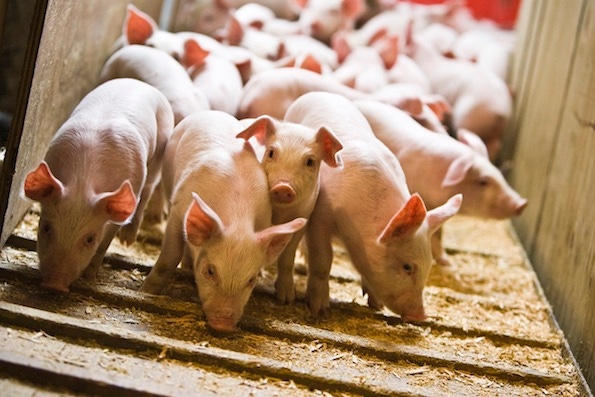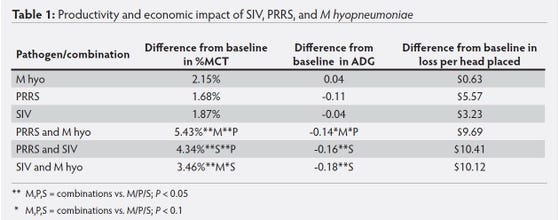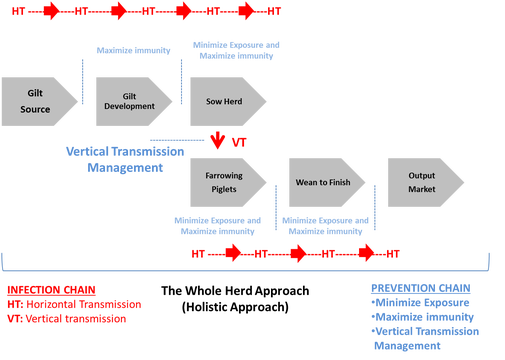Co-infections cause chaos to your bottom line
Hog producers need to take holistic approach to control respiratory diseases.
December 1, 2015

SPONSORED: Respiratory disease co-infections have become so common that the industry coined the term porcine respiratory disease complex (PRDC) to describe it. Co-infections with more than one virus or bacteria working together synergistically with environmental stressors cause significantly more damage to pig health and a producer’s ROI than the pathogens would independently.
The key diseases in PRDC are porcine reproductive and respiratory syndrome virus (PRRSv), Mycoplasma hyopneumoniae (M. hyo) and influenza A virus in swine (IAV-S); plus there’s a long list of secondary bacteria that are included, as well.
When it comes to prevalence, the US swine industry doesn’t do a good job tracking PRDC, says Derald Holtkamp, DVM and assistant professor in the College of Veterinary Medicine at Iowa State University.
“Right now, we rely on syndromic surveillance, and we need to move beyond that to a more routine diagnostic approach, and then share that information widely,” said Dr. Holtkamp. “For growing pigs, we frequently monitor their status at placement, so we know what pathogens came with them, but we need to track their status throughout the growing period.”
Being in a hog dense area, high prevalence of PRRS and M. hyo are very common, and they are commonly found together in herds, said Randy Jones, DVM with Livestock Veterinary Services in Kinston, North Carolina.
“You have to peel that onion back one layer at a time and control what you can. The sow herd plays a big role in how pathogens move through the herd vertically from sow to pig, but you also have lateral or outside pathogen introductions at the same time. It’s often difficult to control those factors,” noted Dr. Jones. “PRDC is dynamic and requires diagnostics and constant monitoring.”
The cost of co-infection
A 2012 study estimated the productivity and economic impact of co-infections in swine (Dykhuis Haden C, 2012). The impact of IAV, M. hyo and PRRSV alone was $3.23, $0.63 and $5.57 per pig placed. However, when more than one of these pathogens was diagnosed together for a group of pigs, the economic impact was dramatically higher: $9.69 for PRRSV and M. hyo; $10.41 for PRRSV and IAV; and $10.12 for IAV and M. hyo. (refer to Table 1).
"PRRS impacts the lung’s ability to wipe out disease pathogens leaving them open to secondary diseases," according to Dr. Jones. "This co-infection is the basis for PRDC. The more pathogens involved, the more severe the morbidity and mortality.”
If you're just using one tool to control PRRS and M. hyo, your approach is too narrow, said Dr. Holtkamp. You've got to manage immunity and exposure holistically. 
Managing PRRS and M. hyo
To manage PRRS and M. hyo, first determine the status of these pathogens in a specific herd. That means determining if the pathogen is present, and if so, where is it active and circulating by phase of production including gilt pool, sow herd and growing pigs in the nursery and grow/finish stage. Understanding the infection pattern of each pathogen helps target protocols to control and manage horizontal and vertical transmission risks.
The process of determining pathogen status usually requires a diagnostic investigation or profile followed by diagnostic monitoring to ensure that control and management protocols are tracking progress to target goals.
Following are the PRRS status definitions; M. hyo definitions would be similar:
Positive/unstable – positive pathogen in the breeding herd (acute or chronic/endemic) and weaning positive piglets
Positive/stable – positive breeding herd that had prior exposure to pathogen, but weaning negative piglets
Provisional negative – previous exposure in the sow but no pathogen present currently, weaning negative pigs
Negative – no exposure, weaning negative pigs
An example of a protocol for PRRS might include:
Gilt Pool
Prepare and develop immune and non-shedding gilts for entry to positive/stable breeding herds. To monitor replacement gilt status, take serum and/or oral fluid samples for PRRS PCR and ELISA to know status of replacement gilts at entry to the gilt development unit (GDU) and exit of the GDU – prior to entry to the breeding herd.
Sow Herd
Test PRRS PCR samples from “due-to-wean” piglets to assess PRRS status of the breeding herd and whether a PRRS positive breeding herd is stable or unstable.
Presence of PRRS in PCR samples of “due-to-wean” piglets is evidence of active PRRS circulation in the breeding herd, and the herd would be considered “unstable”.
PRRS negative PCR samples in at least 4 or more consecutive monthly samplings of “due-to-wean” piglets is evidence of no active PRRS circulation, and the herd would be considered “stable”.
Growing Pig Flow
Test serum and/or oral fluid samples for PRRS PCR to assess PRRS status at the end of nursery phase (nursery exit) and mid- to late-finishing phase.
An example of a protocol for M. hyo might include:
Gilt Pool
Prepare and develop immune and non-shedding gilts. Under ideal conditions, gilts should start the acclimation process as early as possible, allowing ample time for safe and effective exposure to infectious animals and recovery from disease and shedding prior to their first farrowing (at 350 days of age).
Exposure validation – monitor M. hyo status with laryngeal swabs at ~120 days of age and re-vaccinate.
Sow Herd
For a Positive/Stable herd with low M. hyo prevalence at weaning (≤ 10%), diagnostically monitor M. hyo status using laryngeal swab test of 30 due-to-wean piglets (three consecutive samplings every other week; test at least quarterly).
Grow Pig Flow
Vaccinate at 21 days of age and monitor M. hyo status with laryngeal swabs at 6-8 weeks of age. If ≥20% are positive, you will need to identify and investigate the gilt and sow herd links for exposure.
PRRS comes first
PRRS is the most economically significant swine disease and has significant biologic and economic impacts in both the breeding herd and growing pig flows. Active PRRSv circulation and infection can make controlling secondary infections more challenging.
"It's important to accurately assess the PRRS status of a farm by phase of production so an effective and targeted control and management program can be put in place," said Dr. Reid Philips, Boehringer Ingelheim Vetmedica, Inc. PRRS technical manager. "Controlling PRRS can make controlling the secondary infections less challenging."
Vaccinate as part of a holistic approach
Vaccination plays an important role in mitigating the consequences of infection, reducing transmission of the pathogen and improving pig health. However, it should always be used as part of a holistic management program. For example, a stabilization protocol like Load-Close-Expose works to mitigate acute or chronic/endemic transmission of pathogens throughout the entire herd.
Load the farm with replacement gilts in preparation for a period of closure
Close the farm to new entries for typically 200 days or more
Expose the herd by applying a mass vaccination strategy with a modified live vaccine
"This protocol helps generate uniform population immunity at a point in time, and over time can reduce the pattern of circulation and infection, ultimately achieving stabilization" Dr. Philips said.
Other management protocols need to be put into place along with vaccination as part of a holistic program.
"Normal farrowing room practices, such as cross fostering piglets – moving piglets between litters or rooms – and holding smaller pigs back at weaning should be discontinued until the breeding herd has stabilized," Dr. Philips said. "If you have virus that's circulating, those kinds of practices can promote ongoing chronic-endemic shedding of virus within farrowing rooms, and you will continue to wean virus positive pigs."
Farrowing room protocols such as McRebel are employed to manage these transmission risks. These principles also apply for M. hyo infection and Prevention Chain management tactics.
A holistic approach for M. hyo, like PRRS, involves proper gilt acclimation, sow herd stabilization procedures and piglet vaccination to mitigate the consequences of M. hyo infection at the whole herd level.
Ongoing biosecurity plays a critical role in a holistic management approach. The main goal is to maximize immunity and minimize transmission. Biosecurity protocols should be targeted to two areas:
Bio-management
Targeted at biosecurity and management strategies to minimize or prevent internal (within population) transmission of virus
An example is McRebel protocol, which calls for limiting cross-fostering in the face of PRRS
Bio-exclusion
Apply biosecurity that prevents introduction of pathogens coming onto the farm
Examples include transportation biosecurity standard operating procedures and air filtration systems
"Utilizing a holistic and systematic approach to PRDC control, which incorporates an understanding of the Infection Chain, will help target effective interventions," said Dr. Philips. "These interventions, when applied and monitored, will mitigate the consequences of PRDC pathogens, improve health and subsequently improve performance."
You May Also Like



